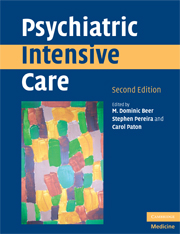Book contents
- Frontmatter
- Contents
- List of contributors
- Preface to second edition
- Preface to first edition
- Foreword
- Part I Therapeutic interventions
- 1 Psychiatric intensive care – development and definition
- 2 Management of acutely disturbed behaviour
- 3 De-escalation
- 4 Rapid tranquillisation
- 5 Pharmacological therapy
- 6 Psychological approaches to the acute patient
- 7 Psychological approaches to longer-term patients presenting with challenging behaviours
- 8 Seclusion – past, present and future
- 9 Restraint and physical intervention
- 10 The complex needs patient
- 11 Therapeutic activities within Psychiatric Intensive Care and Low Secure Units
- 12 Risk assessment and management
- Part II Interface issues
- Part III Management of the Psychiatric Intensive Care Unit/Low Secure Unit
- Index
- References
3 - De-escalation
from Part I - Therapeutic interventions
Published online by Cambridge University Press: 22 August 2009
- Frontmatter
- Contents
- List of contributors
- Preface to second edition
- Preface to first edition
- Foreword
- Part I Therapeutic interventions
- 1 Psychiatric intensive care – development and definition
- 2 Management of acutely disturbed behaviour
- 3 De-escalation
- 4 Rapid tranquillisation
- 5 Pharmacological therapy
- 6 Psychological approaches to the acute patient
- 7 Psychological approaches to longer-term patients presenting with challenging behaviours
- 8 Seclusion – past, present and future
- 9 Restraint and physical intervention
- 10 The complex needs patient
- 11 Therapeutic activities within Psychiatric Intensive Care and Low Secure Units
- 12 Risk assessment and management
- Part II Interface issues
- Part III Management of the Psychiatric Intensive Care Unit/Low Secure Unit
- Index
- References
Summary
The United Kingdom is beginning to see the development of systematic approaches to the prevention and management of violence and aggression. The Mental Health Policy Implementation Guide for Developing Positive Practice to Support the Safe and Therapeutic Management of Aggression and Violence in Mental Health In-patient Settings was published by the National Institute for Mental Health in England (NIMHE) (2004). The Guide places an emphasis on the recognition, prevention and de-escalation of aggressive behaviour and adds that this is best achieved through organisational, environmental and clinical risk assessment and management. One of the key standards set by the Guide is that all staff must be trained in recognition, prevention and de-escalation skills awareness.
Such a programme has been developed by the NHS Security Management Service (SMS) (2004). The National Syllabus for Conflict Resolution training is a generic course for all NHS frontline staff. The SMS is developing a programme specifically to meet the needs of those who work in mental health and learning disability care. This course lasts two days and includes the following modules (Nyberg-Coles 2005):
Recognising violence and understanding causes
Raising awareness of staff and service-user perspectives
The impact of the social and physical environment
Cultural awareness, diversity and racial equality
De-escalation and communication
Problem-solving and risk assessment
Legal and ethical issues
The importance of post-incident reviews and learning the lessons
De-escalation must form part of a hierarchy of responses to aggression in inpatient care. Guidance is continually being developed and evaluated.
- Type
- Chapter
- Information
- Psychiatric Intensive Care , pp. 24 - 31Publisher: Cambridge University PressPrint publication year: 2008
References
- 9
- Cited by

